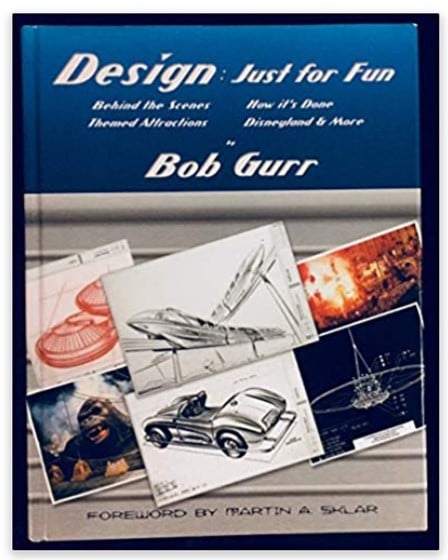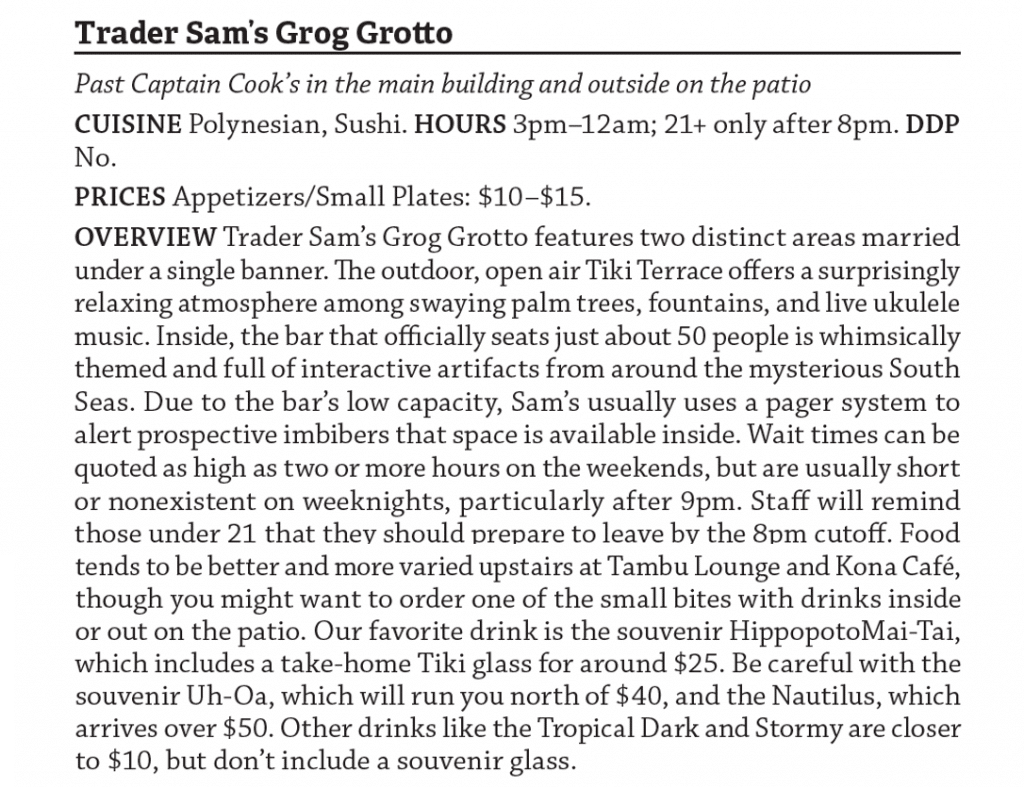Category — A Friday Visit with Jim Korkis
A Friday Visit with Jim Korkis: The Legend of the Lion King
Welcome back to Fridays with Jim Korkis! Jim, the dean of Disney historians, writes about Walt Disney World history every Friday on yourfirstvisit.net.
THE LEGEND OF THE LION KING
By Jim Korkis
Disney’s animated feature The Lion King (1994) was so hugely popular that there were seven different adaptations of the story for different Disney theme parks.
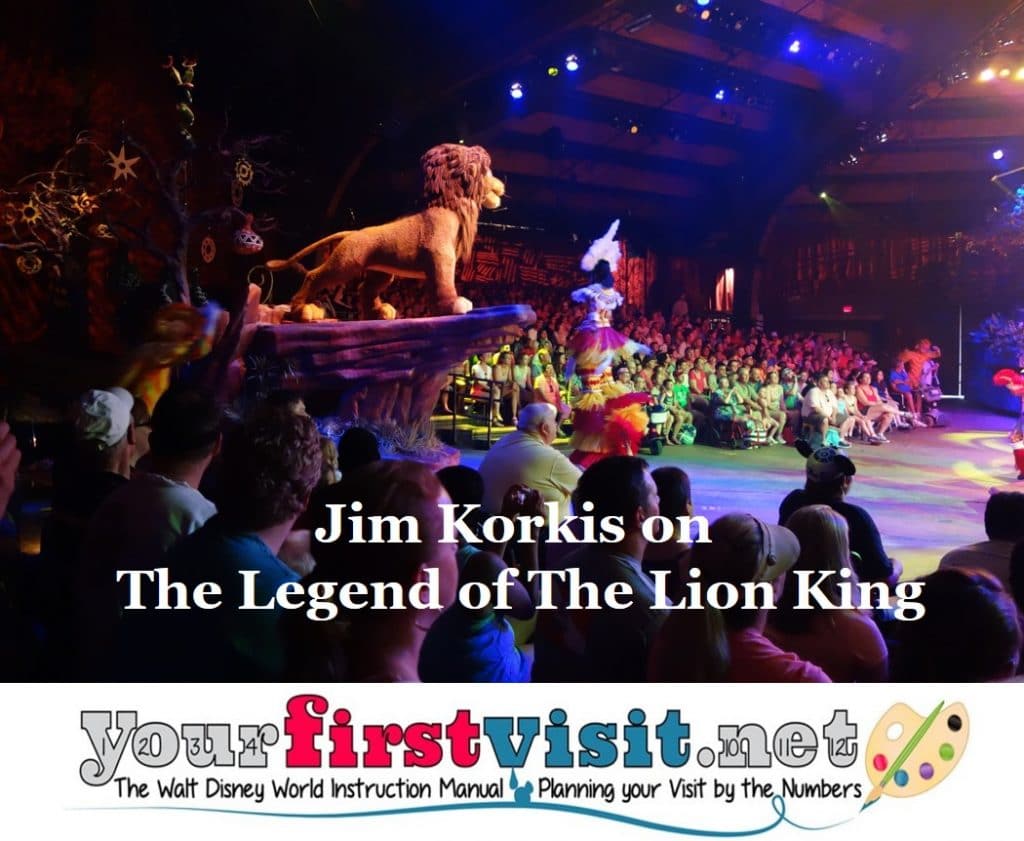
A variation of this show opened in Hong Kong Disneyland in 2005 that instead of being a celebration with Simba and his friends, as it was at Walt Disney World, is a re-telling of Simba’s life by Rafiki. Disneyland Paris had The Legend of the Lion King show with human actors from 2004 -2007 in Discoveryland. That park also debuted The Lion King: Rhythms of the Pride Lands in 2019 in Frontierland.
Also in 2019, Disney California Adventure opened The Tale of the Lion King where a narrator leads a troupe of performers called the “Storytellers of the Pride Lands.”
For the Magic Kingdom, The Legend of the Lion King sponsored by Kodak premiered July 8, 1994 and lasted until February 23, 2002, when it was ousted from its theater in Fantasyland and replaced by Mickey’s PhilharMagic that opened in October 2003.
This Walt Disney World show was unique in its approach to the story of The Lion King, since it used huge, over-sized puppets that Disney dubbed “humanimals”, a human puppeteers trained by people who had worked with Jim Henson and who operated animal puppets from a cramped pit space under the stage.
Ten puppeteers did the show three times per hour and it included a pre-show with a live costumed Rafiki warming up the audience. Rafiki also appeared in the show itself, with narration to help the transition between scenes.
The Mufasa figure measured seven feet long from the tip of the tail to the top of the head, and was perched upon an eighteen foot tall Pride Rock. During the course of the show, Simba grows from a two and a half foot cub to a seven foot full grown lion. In one scene it took five puppeteers to do the movements for just that one large figure.
The stage itself was 125 feet wide, making it larger than the seating area that could hold five hundred guests. That extra width was needed for the set pieces that would move in to the viewing area from every direction, and depicted the rocky Pride lands of Africa, deep jungle, a moonlit watering hole, and the Serengeti grasslands. At the back of the stage was a huge oval screen where clips from the animated film were shown at appropriate times during the show.
“It’s hard to believe they are not live performers in costume,” said show director Fran Soeder who had also directed DHS’s Voyage of the Little Mermaid and The Hunchback of Notre Dame that also utilized puppets. “It’s like watching an animation ‘cel’ from the film come to life. Humanimals provide an exciting new way to translate an animated feature into a Disney stage show.
“Every element of this show seems to live and breathe, including Africa, where the story takes place. Each and every part of this show interacts with the others, making the aduience feel they are in the heart of the film.”
The show included the beloved songs from the film on a pre-recorded track including Circle of Life, I Can’t Wait to Be King, Be Prepared, Can You Feel the Love Tonight and Hakuna Matata. The cast included Mufassa, Simba, Nala, Scar, Zazu, Pumba, Timon and the hyenas Shenzi, Banzai and Ed.
* * * * *
Thanks, Jim! And come back next Friday for more from Jim Korkis!
In the meantime, check out his books, including his latest, Disney Never Lands, and about planned but unbuilt concepts, and Secret Stories of Walt Disney World: Things You Never You Never Knew, which reprints much material first written for this site, all published by Theme Park Press.
Follow yourfirstvisit.net on Facebook or Twitter or Pinterest!!
February 7, 2020 No Comments
A Friday Visit with Jim Korkis: Bob Gurr
Welcome back to Fridays with Jim Korkis! Jim, the dean of Disney historians, writes about Walt Disney World history every Friday on yourfirstvisit.net.
YOUR PERSONAL DISNEY LIBRARY (25)
By Jim Korkis
- Design Just for Fun by Bob Gurr
- Bob Gurr Legendary Imagineer by Bob Gurr
I’ve known Bob Gurr for years, and he even wrote the foreword for my book The Unofficial Disneyland 1955 Companion, but that friendship does not influence my saying that both of his books are valuable additions to your Disney library.
They give insight into the process of Imagineering as well as never-before revealed stories about some of the incidents and people who worked on building Disneyland and Walt Disney World. He is justifiably proud of what he has done but does not brag or overstate his accomplishments, which is refreshing.
Imagineer Gurr designed and built most, if not all, the major ride vehicles at Disneyland and later at Walt Disney World including the Autopia cars, Monorail, Doombuggy, Submarine, Main Street “antique” cars and more. He is a no-nonsense, opinionated Disney Legend, and his honesty comes across in his books, where he doesn’t hesitate to tell it like it is, rather than putting a positive “Disney spin” on the story.
Design Just for Fun is a hardcover book with just over two hundred pages that came in two editions (red cover that was autographed and blue cover that was not, but both contain the exact same content) for a limited edition of only one thousand copies and was released in 2012. It quickly went out of print and Bob insists he will never reprint it because it was a limited edition. Trying to obtain a copy today can cost a couple hundred dollars.
The book is a compilation (revised and expanded) of columns he originally wrote for the Laughing Place website that have since been removed from there. Roughly two-thirds of the book covers his work at Disney from 1954 until he left in 1981 and formed GurrDesign, Inc. with the other third looking at his subsequent work, including the creation of the original King Kong for Universal Studios Hollywood.
The chapters are short since they started as a simple column. There are 65 of them, meaning that they generally run about two or three pages and are filled with many black-and-white as well as color photos that you probably never previously saw anywhere else. The concentration is not on his life but the jobs he did. It is anecdotal and sometimes technical but always fascinating. The foreword is by Marty Sklar.
Bob Gurr Legendary Imagineer: Life and Times – Disney and Beyond is a softcover that runs just less than two hundred pages and was released in 2019. There are thirty-two chapters and again each is short. Unfortunately, there are no photos or illustrations at all other than the cover. Bob intended this to be a “companion” to his previous book so doesn’t rehash that information.
Like the first book, the content here is “chatty” and reveals a little more personal information. He doesn’t limit himself to Disney but talks about his love of aviation and auto racing, and his philosophy of living among other things so only about a dozen chapters focus just on Disney.
If you are a real fanatic, you can try tracking down Bob Gurr’s first book, How To Draw Cars of Tomorrow (by “Henry Gurr”) was published in 1952 followed up with Automobile Design: The Complete Styling Book (by “R.H. Gurr”) in 1955.
These books were written before his involvement with Disney, and focus on car design and technique. Why the “other” names? Over the decades Bob has gone by Robert Henry Gurr, Henry Gurr, R.H. Gurr, Bob Gurr, and even Gurrini (“Italian sports cars were the big thing. My sports car sketches in 1952 carried the identity – Stabilimenti Gurrini, as in Stabilimenti Ferrari.”). Walt Disney called him “Bobby”.
You won’t find this information in his books. This is something extra for readers of this website. In addition, there is also a DVD documentary sometimes available Bob Gurr: Turning Dreams into Reality.
* * * * *
Thanks, Jim! And come back next Friday for more from Jim Korkis!
In the meantime, check out his books, including his latest, Disney Never Lands, and about planned but unbuilt concepts, and Secret Stories of Walt Disney World: Things You Never You Never Knew, which reprints much material first written for this site, all published by Theme Park Press.
Follow yourfirstvisit.net on Facebook or Twitter or Pinterest!!
February 1, 2020 No Comments
A Friday Visit with Jim Korkis: Trader Sam’s
Welcome back to Fridays with Jim Korkis! Jim, the dean of Disney historians, writes about Walt Disney World history every Friday on yourfirstvisit.net.
TRADER SAM’S GROG GROTTO
By Jim Korkis
Trader Sam’s Grog Grotto opened in Disney’s Polynesian Village Resort in April 2015 as part of the rehab of that resort. The new bar was the work of former Imagineer Brandon Kleyla, now a member of Universal Creative, who was also responsible for Trader Sam’s Enchanted Tiki Bar that opened at the Disneyland Hotel in Anaheim in May 2011.
The character of Trader Sam is a cannibal salesman prominently located near the end of the iconic Jungle Cruise attraction since Disneyland opened in 1955. He is the “head salesman” of the jungle, trying to get ahead by offering two of his shrunken heads for “one of yours” because “his business is shrinking”.
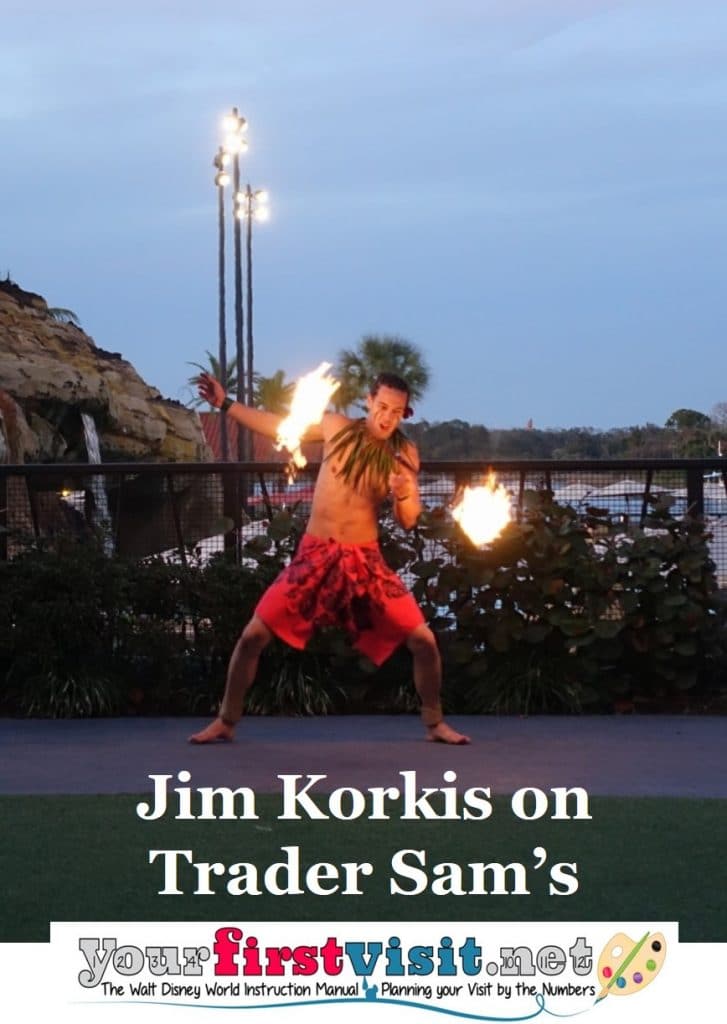
As Kleyla told me when I interviewed him in 2019, “Anaheim Trader Sam is the true Trader Sam. This came up several times when we started working on the Florida Trader Sam’s. At one point it came up to remove the Marc Davis Sam from the Jungle Cruise attraction and replace him with Anaheim Sam, which I think the majority of us opposed.
“So I simply came up with the fact that the Florida Sam is Anaheim Sam’s cousin, and he runs the east coast. Simple and we get the best of both. And I concreted that idea by creating a black and white photo of the two of them standing together and posted it on the wall.
“Sam’s expertise in head-shrinking potions grew into an interest in mixology. Bitten by the bartending bug (just one of thousands he’s been bitten by), Sam sailed the Seven Seas. Countless tropical locales were explored for mystical ingredients to mix into his delectable libations.
“Along the way, he picked up many of trinkets and artifacts that you see around here. In the tiki bar business, it’s a jungle out there. But once Trader Sam began serving his exotic elixirs to his guests, the word really spread!”
The Enchanted Tiki Bar in Anaheim is set during the time period of 1930-1950 while the Grog Grotto reflects 1950-1970. It includes more elements of the extinct Magic Kingdom 20,000 Leagues Under the Sea attraction because that was an iconic Walt Disney World ride.
Kleyla said, “I just wanted the bars to be a dash of Adventureland, two dashes of Jungle Cruise, a sprinkling of Indiana Jones, and a little Enchanted Tiki Room icing on top. One of my biggest concerns was that we had to make sure people knew that this wasn’t The Adventurers Club, even though there are interactive elements.
“I grew up in Florida and was always too young to get into the Adventurers Club. So I actually never got to go in ever! I was there for the night it was closing and didn’t get in so I did not get a chance to experience The Adventurers Club.
“That being said, I certainly did my homework, talked to some of the original cast, and watched plenty of videos. Certainly there are references to the Club in both locations but we tried hard to differentiate ourselves.
“When it came to salvage the Club, most of the stuff was in such bad shape from just being in there so long, that you really couldn’t get much more use out of it. That and the fact that people were stealing things right off the walls before the club closed. A lot of the stuff from the Club actually got picked over and taken to Mystic Manor in Hong Kong.”
* * * * *
Thanks, Jim! Here’s the review of Trader Sam’s from our book:
And come back next Friday for more from Jim Korkis!
In the meantime, check out his books, including his latest, Disney Never Lands, and about planned but unbuilt concepts, and Secret Stories of Walt Disney World: Things You Never You Never Knew, which reprints much material first written for this site, all published by Theme Park Press.
Follow yourfirstvisit.net on Facebook or Twitter or Pinterest!!
January 24, 2020 No Comments
A Friday Visit with Jim Korkis: Expedition Everest
Welcome back to Fridays with Jim Korkis! Jim, the dean of Disney historians, writes about Walt Disney World history every Friday on yourfirstvisit.net.
EXPEDITION EVEREST: LEGEND OF THE FORBIDDEN MOUNTAIN
By Jim Korkis
According to the Imagineering back story in the queue line of Expedition Everest: Legend of the Forbidden Mountain, two business men, Bob and Norbu, have rebuilt an existing railroad that once transported tea in order to take travelers to the base of Mount Everest for profit. The railroad journey goes through the Forbidden Mountain that is in the path to the final destination.
As travelers exit Bob and Norbu’s office, they begin to see shrines of the yeti in various sizes. The majority of these shrines are showered with jewels and food, symbolizing the tremendous respect the locals have for the yeti. Previously, guests saw shrines and prayers flags and red paint (to ward off evil spirits).
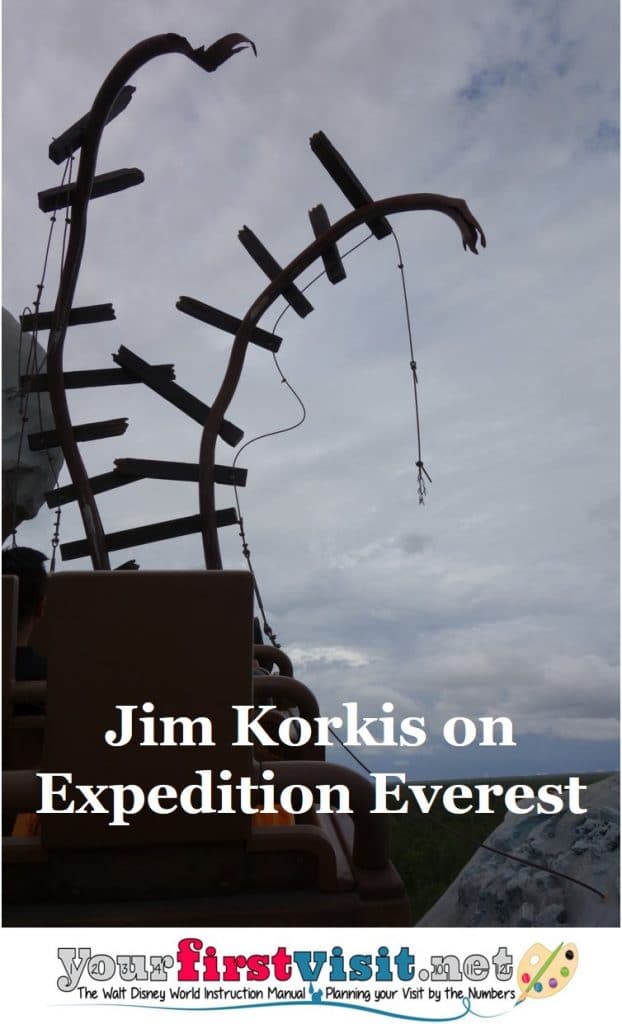
The first half of the museum focuses on the geographic region of Nepal, the people of Nepal, and their interpretations of what they believe the yeti to look like. This setting is meant to establish a sense of reality before venturing into the fantasy elements.
Next, the Lost Expedition of 1982 is displayed in the museum. Legend has it that in 1982, a group of trackers went in search of the yeti. When none returned after several weeks, a search group was sent to find these trackers only to discover they had not survived. The remains of their expedition, including their tent, hiking equipment and camera, are shown throughout the exhibit.
A little more than halfway through the museum, travelers notice pictures of lowland jungle animals, midland forest animals and mountain animals. The purpose of this display is to rationalize that if these animals can survive the different areas of the mountain, then why can’t a creature like the yeti also survive?
Towards the end of the Yeti Museum, travelers notice a brown display cabinet filled with actual different discoveries that Walt Disney Imagineers made during an expedition by Disney and Conservation International to the Himalayas, meant once again to establish a sense of reality.
Upon exiting the museum to board their train, travelers see one last warning sign posted by Professor Dorje: “Respect the Power of the Yeti. The weight of the evidence leads to the inescapable conclusion: The Yeti is Real. You are about to enter the scared domain of the Yeti, guardian and protector of The Forbidden Mountain. Those who proceed with respect and reverence for the sanctity of the natural environment and its creatures should have no fear. To all others, a warning you risk the wrath of the Yeti. Prof. Perma Dorje, Ph.D Curator The Yeti Museum.”
Of course, Bob and Norbu can not allow the good professor to scare off potential customers and so they also post a sign that reads: “The opinions expressed by the curator of the Yeti Museum in no way reflect the views of the owners and operators of Himalayan Escapes, Tours and Expeditions.”
* * * * *
Thanks, Jim! And come back next Friday for more from Jim Korkis!
In the meantime, check out his books, including his latest, Disney Never Lands, and about planned but unbuilt concepts, and Secret Stories of Walt Disney World: Things You Never You Never Knew, which reprints much material first written for this site, all published by Theme Park Press.
Follow yourfirstvisit.net on Facebook or Twitter or Pinterest!!
January 17, 2020 No Comments
A Friday Visit with Jim Korkis: Twilight Zone Tower of Terror
Welcome back to Fridays with Jim Korkis! Jim, the dean of Disney historians, writes about Walt Disney World history every Friday on yourfirstvisit.net.
TWILIGHT ZONE TOWER OF TERROR
By Jim Korkis
While variations of the Tower of Terror attraction have been at four different Disney theme parks worldwide, one of the things that makes the Walt Disney World version unique among them is the inclusion of the horizontal journey through the Fifth Dimension experience.
Every week the Twilight Zone television show began with host Rod Serling telling viewers that, with the key of imagination, one unlocks the door to another dimension.
The idea of another dimension was shown in the Little Girl Lost episode (March 1962) where a little girl named Tina falls into another dimension through the wall behind her bed. The premise for the Tower of Terror attraction is that the ill-fated elevator passengers have fallen into a new dimension and have been trapped there never aging for decades. They are not ghosts.

The Tower of Terror actually employs more than one type of vehicle in order to enable riders to leave the elevator shaft and pass through the Fifth Dimension. Guests sit in Autonomous Guided Vehicles (AGVs), which rise up to the corridor scene in a Vertical Vehicle Conveyance (VVC).
At the time work began on the attraction, United Technologies was the sponsor of the Living Seas pavilion at Epcot. UT owned a subsidiary, Otis Elevator that had pioneered the development of the safety elevator in 1852 that would lock it in place if the ropes failed. Originally, because of their reputation, they balked at the idea of being involved with an “unsafe” elevator but were persuaded it would be good publicity.
The self-guided vehicle was assigned to Eaton-Kenway, a manufacturer of computerized pallet drivers for automated warehouse inventory transport. There were challenges getting both systems to work in tandem.
When guests reach the Fifth Dimension corridor, the AGVs exit not on a track like a traditional dark ride vehicle but are guided by wires under the floor. This technology was originally developed for the vehicles in Epcot’s Universe of Energy attraction and The Great Movie Ride.
When they reach the far end of the corridor, they lock into another vertical motion cab, which handles the actual drop sequence.
The AGVs are powered by onboard batteries, which are charged while riders are unloading. At any one time, up to eight of these vehicles could be circulating around the Tower of Terror’s ride system. Ten were originally built.
While there really are two drop shafts on the Tower of Terror, there are actually four elevators that lift the AGVs from the boarding area up to the Fifth Dimension scene – two of these merge into a single corridor scene. This enables the ride to have an increased capacity.
Unlike other amusement park drop rides like Magic Mountain’s Freefall, guests are not in fact being pulled down by gravity. In fact, they are moving faster than the speed of gravity to a top speed of 39 miles per hour.
Once the AGV vehicles are locked into the Vertical Vehicle Conveyance (the elevator housing), they are pulled by cables connected to two enormous motors which are 12 feet tall, 35 feet long and weigh a massive 132,000 pounds. These pull the VVC up and down.
When the attraction was going through the test and adjust phase, it was found that the VVC was being pulled down so rapidly that it was compressing the air at the bottom of the shaft and blowing out the walls, so adjustments had to be made.
Besides the Fifth Dimension scene, other differences unique to the WDW version are some particular Twilight Zone artifacts and references, but that would need another column to cover!
* * * * *
Thanks, Jim! And come back next Friday for more from Jim Korkis!
In the meantime, check out his books, including his latest, Disney Never Lands, and about planned but unbuilt concepts, and Secret Stories of Walt Disney World: Things You Never You Never Knew, which reprints much material first written for this site, all published by Theme Park Press.
Follow yourfirstvisit.net on Facebook or Twitter or Pinterest!!
January 10, 2020 2 Comments
A Friday Visit with Jim Korkis: The Disney Institute
Welcome back to Fridays with Jim Korkis! Jim, the dean of Disney historians, writes about Walt Disney World history every Friday on yourfirstvisit.net.
THE DISNEY INSTITUTE
By Jim Korkis
CEO Michael Eisner and his family visited the Chautauqua Institution in 1985 in upstate New York. Chautauqua offered lectures, performances, recreation, and, most specifically, classes designed for adults to enhance their education during the summer months. Eisner felt this would be a great idea to build at Walt Disney World and would attract older, more affluent guests who were not interested in the theme parks.
In order to save on costs on the venture, it was decided to convert the already existing Lake Buena Vista villas and townhouses into housing for what would become the Disney Institute, and just build the additional classroom facilities there.
The new structures were designed by Tom Beedy and given the look of a small, friendly New England town. Facilities at the 457-room lakeside resort were designed to accommodate about 900 people at its peak, a fairly modest number considering the other resorts and attendance at the theme parks.

Some upgrades to the Lake Buena Vista living accommodations were made, but most of these were merely cosmetic, so for example there were few outlets to plug in and recharge any devices like a computer. The prices were going to be the same as the premium resorts on property but without the same amenities.
The Disney Institute opened on February 9, 1996 with the motto “You won’t believe what you can do!”
Too often guests stayed at other resorts and simply drove in to attend classes or performances. The classrooms were designed to be small for an intimate experience but even with a full classroom it was not enough to cover the cost of the overhead for instructors, materials, maintenance and more.
When Disney Institute opened in 1996, guests could choose from more than 80 programs in nine different program track areas, including Entertainment Arts (which also encompassed all the animation classes), Sports and Fitness, Life Styles, Story Arts (with classes like As Walt Would Tell It), Culinary Arts, Design Arts, Environment (including a class where guests could make their own mini-Mickey Mouse topiary), Performing Arts (with a radio and television studio) and Youth Programs. Within six months many of these classes were cut, with only the more popular ones surviving and another round of massive cuts happening later in 1997. The Disney Institute in its first year of existence had the highest guest satisfaction ratings on all of WDW property.
Individual classes were each offered generally twice or three times a week (usually every other day) and were roughly two to three hours long. There was a morning session and an afternoon session. There was a two hour break for lunch and in the evening there were events either in the Performance Center or the Cinema.
Eventually, the guest enrichment programs slowly disappeared entirely and Disney Institute closed as a physical location in 2002. The Disney Institute still exists today in name offering expensive business classes on location to corporate clients throughout the world from their cubicles in Celebration.
Many things on the physical site were gutted and razed when the area was transformed into the Saratoga Springs resort that opened on May 17, 2004.
* * * * *
Thanks, Jim! And come back next Friday for more from Jim Korkis!
In the meantime, check out his books, including his latest, Disney Never Lands, and about planned but unbuilt concepts, and Secret Stories of Walt Disney World: Things You Never You Never Knew, which reprints much material first written for this site, all published by Theme Park Press.
Follow yourfirstvisit.net on Facebook or Twitter or Pinterest!!
January 3, 2020 No Comments



